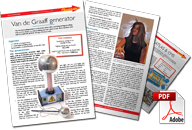Beach ball accelerator
How can we use a wave to accelerate particles? The whole audience is involved in this massive, chaotic, hands-on visualisation of what that rather cryptic idea means, as we accelerate beach balls using a Mexican wave.
Apparatus
n × beach balls
n/2 × electric pumps
The demonstration
- Place approximately as many beach-balls as there are rows in the audience at one side of the auditorium.
- Encourage the audience to do a ‘Mexican wave’, transporting the beach-ball along its crest and accelerating it from stationary to nearly the speed of light.
Vital statistics
scale model protons:
a 1 m beach ball is around 1015 times larger than a proton
What it shows
In an accelerator, the charged particles are accelerated by an electromagnetic standing wave, resonating within a radio-frequency, or RF, cavity. That’s obviously something of a mouthful, and indeed a mind-full, so the concept is got across in stages, the first of which being how it’s possible to use a wave to accelerate a particle. The beach-ball, or proton, surfs along the ‘Mexican wave’ of humans, gathering speed. This is in much the same way as a surfer surfs on a water wave, gaining speed—and therefore energy—as they do so. Similarly, we can use an electromagnetic wave to accelerate particles surfing along on it.
Another important feature of RF cavities which this demo could be used to illustrate to a more advanced audience is the importance of synchronisation: if an audience member stands up before the beach-ball arrives, or after it’s passed, there won’t be any additional acceleration. By analogy, it’s like making sure you push a roundabout when one of the bars is passing your hand, or you won’t provide any energy to increase its rotational speed. Similarly, the rapidly-alternating fields inside an RF cavity must be synced precisely with the particles zooming through them lest they fail to accelerate or, worse, actively decelerate the beam!



